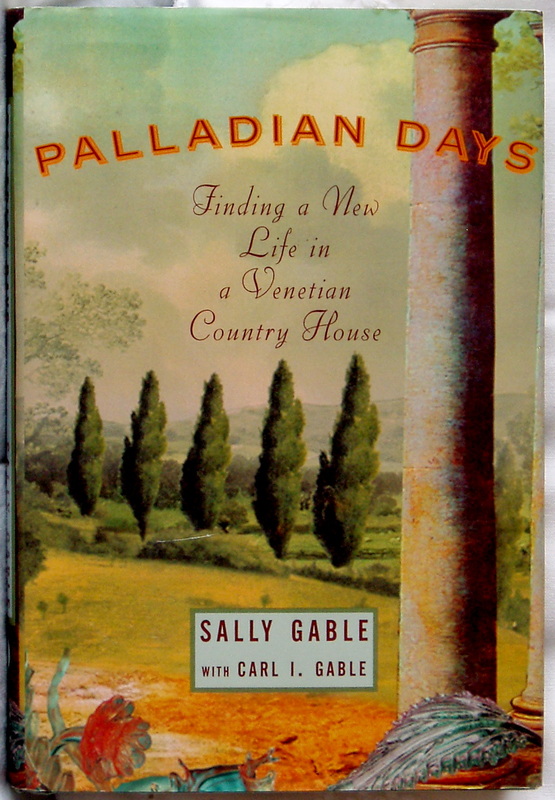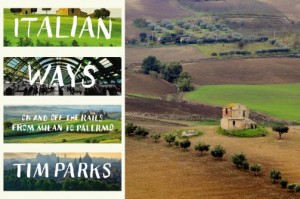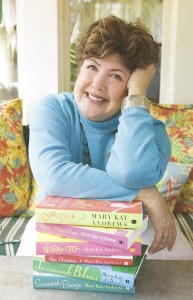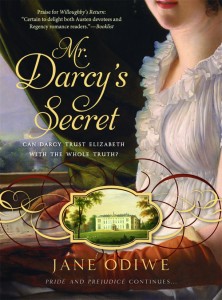Today I’m going to talk about a book and about a family story. The book made a real impact on me, and it cleared the way for me to memorialize a family story without keeping the artifact. That’s what this book is all about.
Tag Archives: Book Review
The Saturday Review: Wine and Cheese
 When I’m traveling in my car, I usually choose light cozy books in which I’m unlikely to be shocked by overt sex and graphic language, since one can hear my speakers outside of my car if I’m at an intersection or in a parking lot. That was one of the reasons I chose The Merlot Murders by Ellen Crosby; it looked interesting but also safe. I was also intrigued by the idea of a book based in Virginia’s wine country, rather than California or France. My choice did not disappoint; it’s an easy murder mystery with enough intrigue and surprise built into the plot to keep me guessing. The book is the first of a series about Lucie Montgomery and her family’s winery, and I was encouraged enough by the first book to go on to the second. The Chardonnay Charade was just what I expected — another cozy murder mystery with a little romantic spice built into the story. Thank goodness my library has the books so I don’t have to keep buying them; I just put holds on the other four titles and will enjoy spinning through them over the next few weeks. Continue reading
When I’m traveling in my car, I usually choose light cozy books in which I’m unlikely to be shocked by overt sex and graphic language, since one can hear my speakers outside of my car if I’m at an intersection or in a parking lot. That was one of the reasons I chose The Merlot Murders by Ellen Crosby; it looked interesting but also safe. I was also intrigued by the idea of a book based in Virginia’s wine country, rather than California or France. My choice did not disappoint; it’s an easy murder mystery with enough intrigue and surprise built into the plot to keep me guessing. The book is the first of a series about Lucie Montgomery and her family’s winery, and I was encouraged enough by the first book to go on to the second. The Chardonnay Charade was just what I expected — another cozy murder mystery with a little romantic spice built into the story. Thank goodness my library has the books so I don’t have to keep buying them; I just put holds on the other four titles and will enjoy spinning through them over the next few weeks. Continue reading
The Saturday Review: Two Portraits of Ernest Hemingway
I’ve been on a Hemingway journey for several years, enjoying The Paris Wife, A Moveable Feast, The Sun Also Rises, and Woody Allen’s film Midnight in Paris while armed with my own memories of Paris. Today’s review includes two recent reads about Ernest Hemingway and his world.
At the Hemingways: A Family Portrait
 Originally published in 1962 after the suicide of her famous brother, Marcelline Hemingway Sanford shares stories of growing up with her brother and very family. With their primary residence in Oak Park, Illinois, and their summer home at Walloon Lake, Michigan, I found these local stories interesting just for their history. A newer edition was published in 1998 for the centennial of Hemingway’s birth, and includes correspondence between Ernest and his sister Marcelline. Hemingway’s experiences as a child and young man in Illinois and Michigan, as well as his time in Italy, Paris, and Spain are part of this treasure trove of Hemingway history. Marcelline Hemingway Sanford’s writing is clean and her narratives move along crisply, with wonderful characterization of the family members and friends who influenced Ernest Hemingway. Continue reading
Originally published in 1962 after the suicide of her famous brother, Marcelline Hemingway Sanford shares stories of growing up with her brother and very family. With their primary residence in Oak Park, Illinois, and their summer home at Walloon Lake, Michigan, I found these local stories interesting just for their history. A newer edition was published in 1998 for the centennial of Hemingway’s birth, and includes correspondence between Ernest and his sister Marcelline. Hemingway’s experiences as a child and young man in Illinois and Michigan, as well as his time in Italy, Paris, and Spain are part of this treasure trove of Hemingway history. Marcelline Hemingway Sanford’s writing is clean and her narratives move along crisply, with wonderful characterization of the family members and friends who influenced Ernest Hemingway. Continue reading
The Sunday Review: Burnt Mountain by Anne Rivers Siddons
I really wanted to love this book.
Having just come back from my first visit to Atlanta, I was very excited to read Anne Rivers Siddons’s newest novel. I was totally ready to immerse myself into the intriguing characterization and poetic descriptions that inhabit Siddons’s previous novels, which are set in and around Atlanta. Continue reading
The Sunday Review: Palladian Days by Sally Gable
Carl and Sally Gable were looking for a summer home in New Hampshire, but ended up buying a historically-protected villa in a small town outside of Venice — the Villa Cornaro. Built by Renaissance architect Andrea Palladio in 1552, the Villa Cornaro is considered one of the most beautiful buildings in the world. It is owned by Americans who fell in love with Italy, with Palladian architecture and with the Villa Cornaro. Palladian Days: Finding a New Life in a Venetian Country House is based on Sally Gable’s diaries about the process of buying a home in Italy.
I fell in love with the book based on its cover — very Edith Wharton and all that — and found it to be an interesting look into the world of Americans learning to care for an Italian treasure while also learning to live in another culture. Unlike Tim Park’s sardonic view of Italy and Frances Mayes’s romantic love affair with Italy, Sally Gable’s prose is elegant, precise, and matter-of-fact while still offering a passionate vision of the expatriate dream of owning a villa in Italy. It’s just that most of us don’t own and live in an international monument.
As I read this book, I couldn’t help but think money pit, money pit. I’ve renovated a number of homes in my day, and I know that the amount of money the Gables have poured into this property must be astounding. Carl I. Gable is a retired lawyer and businessman, and Sally Gable is a retired church musician, and Mrs. Gable is pretty reticent about talking about money in her stories. Although most of the restoration had already been done by the villa’s former owners, Richard and Julia Rush, I found it unrealistic how she often glossed over what must have been very difficult decisions. The fact that they both sit on some very prestigious boards of directors gives us a glimpse into why they don’t seem to worry very much about what things cost. I don’t know exactly why this bugged me, but it did.
Sally Gable also includes recipes and a discussion of risotto that had my tastebuds drooling. I do love a good memoir with talk about food!
 This photo of Villa Cornaro is courtesy of TripAdvisor
This photo of Villa Cornaro is courtesy of TripAdvisor
A visitor to the Villa Cornaro tells Sally that she is lucky that she and her husband share a passion for the same thing — renovating, restoring, and living in an architectural treasure. As she reflects on this comment she says:
How fortuitous, how unlikely, that we both find in our villa, in Venice, in Italy a source of such infinite fascination.
Villa Cornaro has been the cornerstone of it all. Like a great athletic coach, the villa is at once a disciplinarian, a trainer, and a motivator.
You can step into new stages and play new roles, the villa whispers. Find your hidden pools of strength, open yourself to see art with fresh and wider-ranging eyes, examine whole new palettes of color in your everyday life, vault past barriers of language, culture, and habit.
All to better care for me, my villa tells me (247).
The Gables open their house to visitors and also host local events in the gardens. If you cannot get to Venice to see Villa Cornaro anytime soon, perhaps you are able to visit a Palladian style architectural treasure in the United States, Drayton Hall near Charleston, South Carolina, that is said to have been based on the Villa Cornaro. Thomas Jefferson admired Andrea Palladio’s work and used another building, Villa La Rotanda, for the design of his home at Monticello.
You can also visit The National Building Museum in Washington, D.C. which tells “the stories of architecture, engineering, and design.”
Got my bags, got my reservations,
Spent each dime I could afford.
Like a child in wild anticipation,
I long to hear that, “All aboard!”
Music and lyrics by Bud Green, Les Brown and Ben Homer (1944)
The Sunday Review: Italian Ways by Tim Parks
I’m an Anglophile recently masquerading as a Francophile. I have not been to Italy yet, but books about Italian culture are certainly on my radar, as we are planning a trip to Italy in the spring with travel writer Linda Dini Jenkins. When my husband bought me a book for my birthday by Tim Parks about rail travel in Italy, I was pretty happy.
Although I’ve never been to Italy, I’ve been a Frances Mayes stalker follower for many years. Her blog is a delight and most of my mind-photos of Italy come from her Bramasole books. I’ve previously talked about Frances here and I’ve referred to her many times over my years of blogging. I’ve also had guest bloggers share their wonderful experiences in Italy, including friends Debbie and Kathy. I’ve been putting together trips to Rome for relatives this week and I’ve been drinking a lot of Italian koolaid. I was ready for Italian Ways: On and Off the Rails from Milan to Palermo.
Although Mayes gave us some idea of the Italian sense of time and place, Tim Parks’s almost sardonic take on Italy and its social structures came as kind of a culture shock to me. I should have know better; many of my blogging friends refer to issues with Italian trains, including Marisol at Traveling Solemates. We have our own issues here in Chicago with trains as well. I don’t know why I was surprised. Italian Ways: On and Off the Rails from Milan to Palermo is exactly what the reviewers say it is — a revealing look at the dynamic between tradition and innovation in modern Italy. Another reviewer describes Italian Ways in this way.
“For every moment that Italy annoys Tim Parks, there are two in which it delights him.”
That’s pretty much the premise of Italian Ways. Parks tells the stories of his train travel in Italy through vignettes of the rail system and of the people he meets along the way — and it’s funny and poignant.
In reading the Christian Science Monitor’s review of this book, I also clicked into their list of top ten travel books to read before you go to Italy. My goodness, I had forgotten about A Room with a View and Daisy Miller. Those are going to definitely be on my reading list for this year, along with a few more visits with Woody Allen in To Rome With Love.
So — should you read Italian Ways? Yes, but be aware that as Andrew Martin of The Observer says, this is a “warts-and-all” look at Italy’s trains and culture. It’s not a love story to Italy like Frances Mayes has penned in Under the Tuscan Sun and its sequels. As a traveler, I want to know about the warts I might encounter while traveling, so for me, it was a great book! Thanks, Music Man, for an excellent birthday present.
The Sunday Review: Mary Kay Andrews — the Princess of Beach Reads (and drives in the car)
Recently a friend asked for book recommendations on Facebook. Knowing that she was planning a trip to France in September, I responded immediately with some favorites from my literary journey through France over the last few years, including The Paris Wife and Extremely Pale Rosé. Everyone else responded with highly regarded cross-cultural novels and nonfiction, making my suggestions appear somewhat frivolous. But did I back down? Non! I offered up an even more frivolous choice — Mary Kay Andrews, the Princess of Beach Reads.
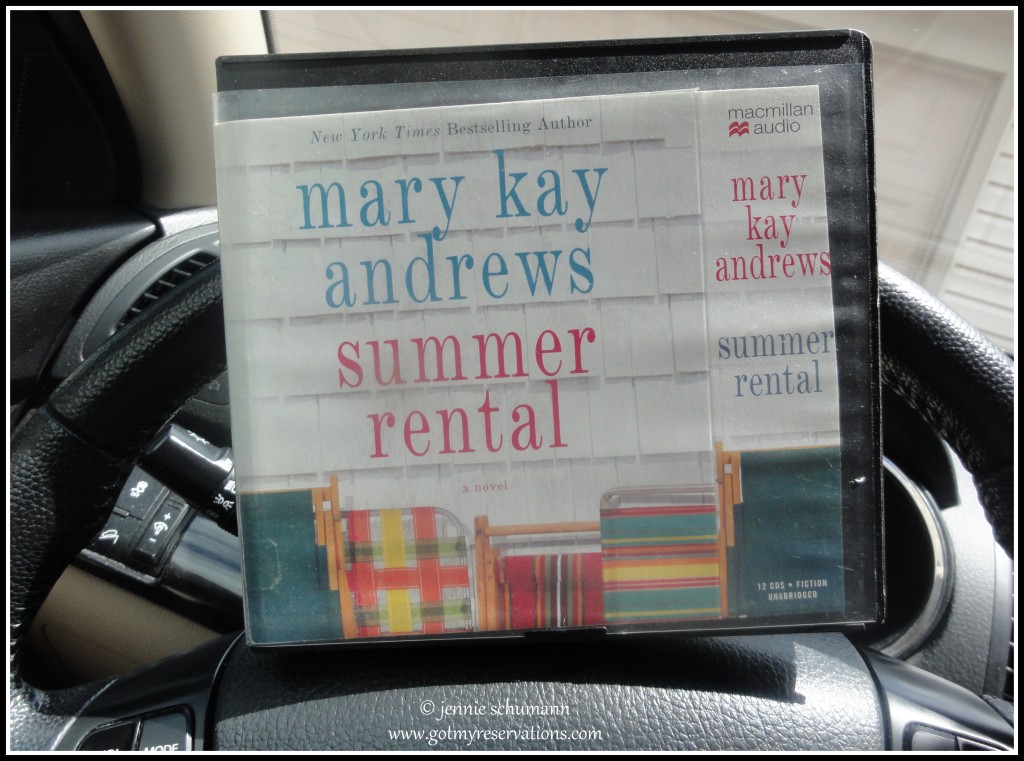 This summer I read several important and lengthy novels, including Paris by Edward Rutherfurd and Cutting for Stone by Abraham Verghese. In the privacy of my car, however, I’ve listened to three Mary Kay Andrews novels, and trust me, they are the perfect beach reads (and car reads).
This summer I read several important and lengthy novels, including Paris by Edward Rutherfurd and Cutting for Stone by Abraham Verghese. In the privacy of my car, however, I’ve listened to three Mary Kay Andrews novels, and trust me, they are the perfect beach reads (and car reads).
I’m always looking for books with a cooking connection, so pulling Deep Dish off the shelf at the library wasn’t much of a stretch for me. I DO live in Chicago, home of the best deep dish pizza in the world, just in case you forgot. Not so much about pizza after all, Deep Dish is a sweet little confection about the rivalry between two television chefs. Since it’s a beach read, you already know what happens to our dueling chefs — they fall in love and we hope they will live happily ever after. Nuff sad about that one.
Next up was Hissy Fit, another sassy tale about an interior designer who finds her fiancé fooling around with her maid of honor at the rehearsal dinner. Humiliated, she tries to rebuild her life by restoring and decorating a crumbling antebellum mansion for the “new guy” in town, who just happens to be fabulously wealthy and willing to spend whatever it costs. Hissy Fit surpasses what one might expect from the title, with charming and well-drawn characters and lots of references to antiques. Chick-lit romances usually end with the girl getting the guy, and this book is no exception, but Andrews has created characters that we like and some we dislike, and the reader cares about them. Another satisfying beach read.
Summer Rental is a beach read that’s actually about the beach. After reconnecting at a funeral, a trio of childhood friends decide to rent a house together at Nags Head, NC, for the month of August. Each woman comes to the vacation with expectations and secrets, and in this well-plotted and well-paced story, the secrets reveal themselves. In addition, they adopt another woman who needs a place to stay to escape her criminal husband, and of course there are the local men who become part of the ladies’ lives. The crumbling beach house really is an additional character in the story as Andrews creates an arc for the house itself — and Hollywood comes calling to rescue it and the hunky landlord who owns it. This book has just fueled my long-standing desire to rent a house on the Outer Banks someday.
Mary Kay Andrews is the pen name for Kathy Hogan Trocheck, who was a newspaper journalist and has written acclaimed mysteries under her own name as well as the lighter chick-lit fiction. Her deep understanding of life in the South, life in small towns, and her humorous yet gentle take on Southern behaviors make these books fun to read. She also knows a great deal about antiques and thrift-shopping, and it shows up in her characterizations — click here to see her junking tips!
Happy reading and enjoy your vacation!
Got my bags, got my reservations,
Spent each dime I could afford.
Like a child in wild anticipation,
I long to hear that, “All aboard!”
Music and lyrics by Bud Green, Les Brown and Ben Homer (1944)
The Sunday Review: Major Pettigrew’s Last Stand and The Reliable Wife
I have read a lot of novels set in English villages, many in the years before I actually experienced them. They usually have a predictable group of inhabitants, including an often curmudgeonly-but-charming primary character, surrounded by secondary characters who revolve around him or her. Major Pettigrew’s Last Stand by Helen Simonson is one of those novels, yet it is much more at the same time.
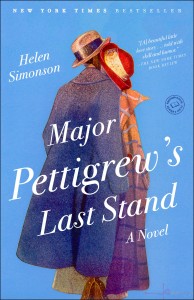 A widowed British army officer lives in his family cottage in the small town of Edgecombe St. Mary and is proud that he lives an upright, circumspect life in his retirement, filled with golf, gentlemanly shooting, and books. The unexpected death of his brother changes everything, and leads him into an unlikely friendship with the local shopkeeper, a Pakistani woman who is also widowed and shares his love of reading. As their relationship changes, Major Pettigrew must take a stand about many traditions and cultural issues that confront him as a result of his friendship with Mrs. Ali, and from there comes the title of the book.
A widowed British army officer lives in his family cottage in the small town of Edgecombe St. Mary and is proud that he lives an upright, circumspect life in his retirement, filled with golf, gentlemanly shooting, and books. The unexpected death of his brother changes everything, and leads him into an unlikely friendship with the local shopkeeper, a Pakistani woman who is also widowed and shares his love of reading. As their relationship changes, Major Pettigrew must take a stand about many traditions and cultural issues that confront him as a result of his friendship with Mrs. Ali, and from there comes the title of the book.
It would not surprise me if modern day villages in rural England teeter precariously between acceptance and prejudice when confronted with residents from other cultures, as Simonson illustrates in this novel. Although she builds snapshot-like caricatures of many of the characters in the book, I’ve seen the dichotomy for myself in the tiny hamlet of Sissinghurst, where the local convenience store and the curry palace next door are both run by Indian or Pakistani owners, right down the street from a traditional English pub and a chips take-away shop. I’ve also been treated as a brash American, even when doing my best to blend in and follow social mores. Major Pettigrew’s Last Stand takes the literary construct of the English village life and gently smacks the reader in the face with white gloves; as you read, you hope against hope that people will do the honorable thing. This book is all about how much you will tolerate; where does your prejudice get in the way of your honor, and where do you draw your own line in the sand?
I thoroughly enjoyed Major Pettigrew’s Last Stand and highly recommend it for readers who enjoy this genre. For more insight into this book, read Alexander McCall Smith’s review here. I listened to it on audiobook and enjoyed Peter Altschuler’s narration; you can also get it from Amazon.com here.
From sweet and heart-warming, we move to a twisted, Gothic romance. I decided to read A Reliable Wife by Robert Goolrick because one of my favorite bloggers is doing a series on books about wives. I had already read The Paris Wife and American Wife (see my review in the link), so it was only natural that I would also want to see what came next. We were all in for a surprise !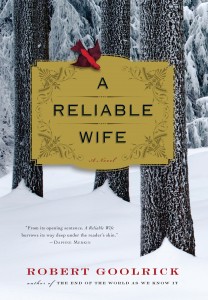
Do not click into the links if you don’t want spoilers!
Emily at The Bookshelf of Emily J hated The Reliable Wife, Ariel at One Little Library had mixed feelings, Angela at Persephone Writes didn’t finish it, and Audra at Unabridged Chick loved it. That in itself would have been enough to make me want to read it — but I’m really glad I read it myself before reading their reviews, because I couldn’t put it down.
Set in bleak Wisconsin and bawdy, tawdry St. Louis and Chicago at the turn of the 20th century, A Reliable Wife tells the story of a trio of obsessive, depraved people who are interrelated in their passions and their unhappy psyches. Ralph Truitt has advertised for “a reliable wife” to join him in the company town that is supported by his factories and enterprises (reminds me of Kohler, Wisconsin). A packet of lies arrive along with Catherine Land, who we quickly find out has plans to murder him for his money — but very slowly, with arsenic that cannot easily be detected — in order to live in style with her younger lover. Robert Goolrick leads us skillfully through the dark twists of this plot and I was surprised how it turned out — and novelists rarely surprise me.
Because at its heart, this book is about sexual obsession and love and what they do to relationships, good and bad, Goolrick packs in the sex. Reviewers complain that the role of the wife is demeaned by this novel, that being a wife isn’t only about a sexual relationship. Others have looked into Goolrick’s past; his autobiography tells us that his own relationships have not been very successful. I did not find the sex to be gratuitous, and felt that it was important to the telling of this gritty story.
Readers who love finding literary allusions will see many; I kept thinking the people from Taliesen in Loving Frank were going to stop by to visit and add to the macabre scene in Truitt, Wisconsin, and I hoped through the whole book that Catherine’s secret garden would rescue her.
A Reliable Wife has been optioned for a movie, and is currently in development. Its wintry snowscapes and luscious scenes of illicit love combined with this Gothic tale will surely make an interesting film!
I encourage you to go back and read the comments on A Reliable Wife after you have finished it, and leave a comment of your own for the book club. If you are interested in reading along with the series, the August 1 novel is The Aviator’s Wife by Melanie Benjamin, a novel about Charles and Anne Lindburgh. I’m adding it to my list!
The Sunday Review: Getting Up to Speed on the Tudor Court
After Friday’s Travel Diary post, I’ve had several requests for the quintessential book about the Tudor Court. Clearly, I cannot name just one. Impossible. I can, however, give you a glimpse into a reader’s history and how I developed a passion for Anne Boleyn’s story.

Yes, that’s me inserted into the Queen Elizabeth I painting. My son gave me this for my birthday last year!
I came into my obsession through a couple of different avenues, but we’ll start with my childhood reading. As a precocious reader, my parents let me run amok in my hometown library, and I devoured everything I could find about the Tudor Court. I was fascinated with how a man, even if he was a king, could somehow get away with having six wives and killing two of them — remember the old saying, Divorced Beheaded Died Divorced Beheaded Lived? I was entranced with how Elizabeth I got to the throne and at some point, I figured out why the current Queen of England was Elizabeth II. I was hooked.
When I began to teach American history, I realized that my students had no idea why the early English colonists left to start over in what they called the New World. The idea of religious freedom had little meaning if not compared to the religious situation the colonists left. Teaching my students about settlements in what we now call the United States made me want to know more at an adult level about the English Civil Wars and the Reformation in Europe.
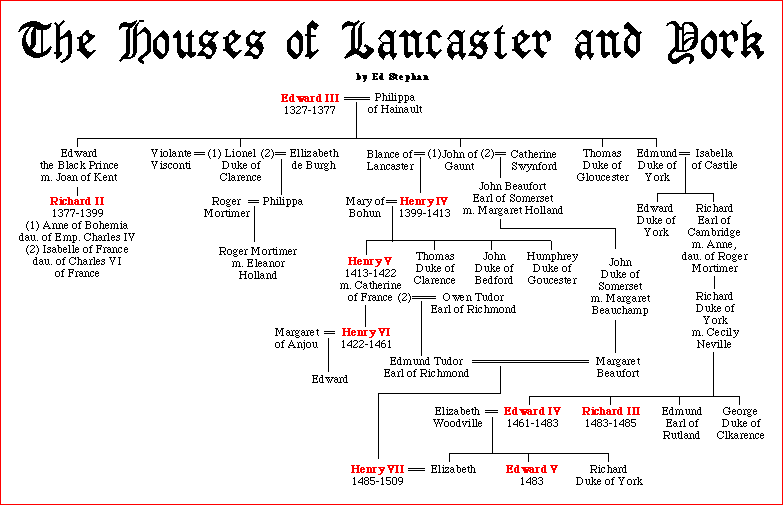
Click into this family tree for more resources on the War of the Roses between the Lancasters and the Yorks and how a Tudor got to be king!
Learning about how the Tudors got to the throne made me finally realize why Henry VIII was willing to do just about anything to get a legitimate male heir. After all that his ancestors went through to get that throne, he was pretty determined to keep it — and why Elizabeth I was just as determined to not let marriage undermine her authority.
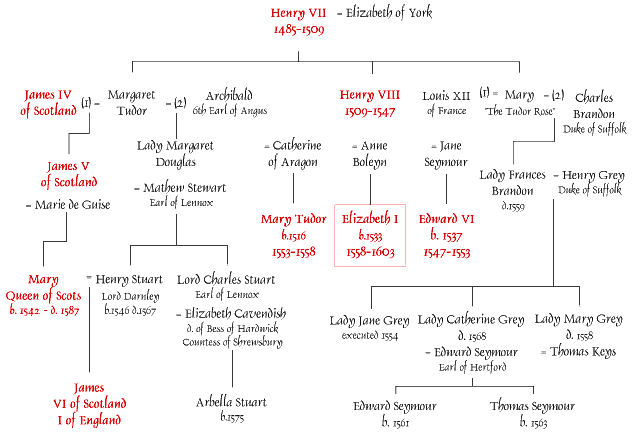
Click into this family tree to find out even more information about what happened to the Tudor line.
Enter current historical fiction and its magic. Most historical fiction being produced today is well-researched and written by fine writers who do a great job of creating compelling stories that are reasonably accurate. There are myriad resources available to the HF writer today; primary sources are collected and shared in great libraries and on the internet. The body of “domestic” documents (diaries, recipe books, household accounts written by women) that have been collected give the authors a much better view into their characters’ lives and it shows in the books they write. I read historical fiction with my internet browser at the ready so that I can either verify or expand on the material presented. It’s a good time to be a writer of historical fiction and an even better time to be a reader. There truly is magic in these books for the adventurous reader.
So what do I recommend? Let’s start with three female writers who are well-known for their work in historical fiction about this time period. I’ve read “quite a bit” of their work . 🙂
Phillipa Gregory is a well-regarded historian and author who has written many novels about the York/Lancaster/Tudor saga and her books are probably the most accessible of the three authors I have chosen for this post. Her web site has a nice feature with her books set against a historical timeline. Personally, if I were starting my reading today, I would follow her timeline and start with The White Queen, the story of Elizabeth Woodville. This book helps set the stage for the rivalries to follow. Next is The Kingmaker’s Daughters, which is followed by her newest and unreleased book about Elizabeth of York, who married Henry VII, thus starting the Tudor line. The Constant Princess depicts a fictionalized version of the life of Catherine of Aragon, Henry VIII’s first wife. The Other Boleyn Girl is loosely based on the life of Mary Boleyn, Anne’s sister, who was Henry VIII’s mistress and that relationship was one of the reasons used to declare the marriage between Anne and Henry null and void. The Other Boleyn Girl was also made into a movie starring Scarlett Johanssen. The Boleyn Inheritance covers the time period of Anne of Cleves and Katherine Howard, with Jane Boleyn finally getting consequences for her actions. The Queen’s Fool takes the reader into the problem of Mary Tudor, the forgotten heir to the Tudor throne. The Virgin’s Lover features Elizabeth I and Robert Dudley, and finally, The Other Queen is the story of Mary, Queen of Scots.
Hilary Mantel is the author of two highly-acclaimed novels about the Tudor Court, written from the perspective of Thomas Cromwell. Both Wolf Hall and Bring Up the Bodies have won the Man Booker Prize in England and are extraordinary extensions for people who already know something about Henry VIII and the political shenanigans that went on during his reign. The third book in the Cromwell trilogy is due to be published in 2015. I loved both of these books and am eagerly awaiting the third of the set.
Last but certainly not least is Alison Weir, also a renowned historian and novelist. She has written so many books about this period that I have just linked up the Alison Weir book list on amazon.com for you to look at. In checking out her online personna, I discovered that she actually leads British history tours. I AM INTRIGUED.
Although none of these ladies wrote a book about Henry’s last wife, Catherine Parr, there are a number of authors that have. I read one of them and was not impressed, but just in case, here’s a link that gives you some options.
More than you wanted to know? I hope not. After all, writers are readers and readers make better writers. I hope you will read some of these books and let me know how you liked them. Want to recommend something else? Go for it — I’m always ready for something new in this genre, and thanks for spending time with my great obsession today!
Bookin’ and Cookin’ — Mr. Darcy’s Secret and Spinach Herb Quiche
Jane Odiwe’s Jane Austen sequels have been sitting on my Goodreads list for a while. I haven’t had much success with Austen sequels; most writers have tried to match Austen’s witty prose and failed and then replaced the wittiness with sex. They were boring and an insult to my beloved Jane’s memory. Some even added zombies and sea monsters to the mix. This one was different and deserves the 4 out of 5 star ratings it receives on both amazon.com and Goodreads.
Elizabeth and Darcy arrive at Pemberley after their marriage, ready to begin a new chapter in their lives. Lizzy is learning to be the mistress of a great estate and in order to encourage Georgiana to be more outgoing, a great ball for her society debut is held at Pemberley. Of course, there is the usual Austen drama involving class struggles, and Elizabeth also tries to reconcile Lady Catherine with Darcy after their falling out over the marriage.
While its suggestive title may lead one to believe otherwise, Mr. Darcy’s Secret is primarily about Georgiana’s love story. She struggles with accepting a marriage proposal from an eligible but indifferent suitor but wants to be dutiful and obey her strong-minded and well-meaning brother. All the while, she is indulging in innocent flirtation with an entirely unsuitable prospect, the landscape architect hired to do some design work on Pemberley’s gardens. As in Jane Austen’s stories, how Georgiana resolves her dilemma is the main story line — and of course, it resolves in a fully Janeite way.
The title refers to a skeleton from Pemberley’s past that the Darcys have in their closet. Trust Caroline Bingley and the local gossip Mrs. Eaton to try to destroy Elizabeth and Darcy’s happy new marriage with hints of secret affairs and illegitimate children, requiring a stiff upper lip and a lot of standing by her man by Elizabeth.
Jane Odiwe uses Austen’s voice effectively, especially when she mimics Mrs. Bennett and Lady Catherine de Bourge, and she continues the characterization created by Austen in her books. All of your favorite characters from Pride and Prejudice show up for their cameos, including the Bingleys, the Bennetts, the Wickhams, the Collinses, the Gardiners and of course Elizabeth and Fitzwilliam Darcy.
While thinking about what I would match up with Mr. Darcy’s Secret for my Bookin’ and Cookin’ series, I stumbled across a wonderful resource. Created by the Jane Austen Centre in Bath, the website has many interesting bits and bobs about Jane. Here also, Janeites can find Regency recipes that Austen’s characters might have been eating, with modern remixes for modern cooks. Spinach Herb Quiche has an interesting history; it is originally a torta recipe from the Renaissance cookbook written by Platina in 1465 and then collected and republished as Cariodoc’s Miscellany by David Friedman and Elizabeth Cook.
A modern remix of an ancient recipe from Renaissance cookbook author, Platina, a Regency version of Spinach Herb Quiche might easily have appeared on the table at Pemberley.
Ingredients
- 9" frozen unbaked pie crust
- 3/4 lb cheddar cheese
- 1/4 t marjoram (dry or fresh)
- 1/2 t sage (dry or fresh)
- 1 t fresh mint
- 1/2 c fresh parsley, stems off
- 1/4 c spinach
- 3 eggs
- 1 cup skim milk
Instructions
Chop all herbs and spinach in food processor. Place in the pie shell.
Grate cheese or chop in food processor. Layer on top of herbs and spinach mixture in pie shell.
Beat egg whites lightly.
Mix milk and eggs together. Pour over greens and cheese mixture in pie shell.
Season with salt and pepper to taste.
Bake in 400 degree oven for 10 minutes; then lower heat to 350 degrees and bake for about another 40 minutes.
Let rest before cutting into wedges for serving.
Notes
While this recipe was fun to make and we enjoyed the unique taste of the herbs, you might prefer my all-time favorite from Julia Child -- Quiche au Fromage de Gruyère, Hambon et Brocoli
Source of original recipe: http://www.janeausten.co.uk/spinach-herb-quiche/


